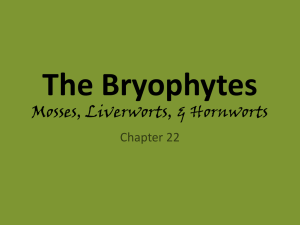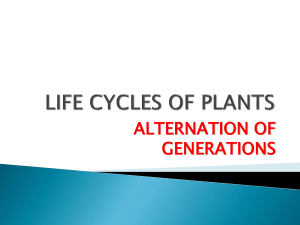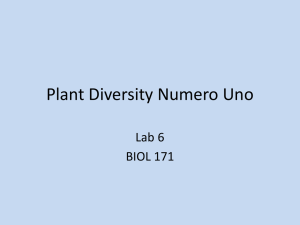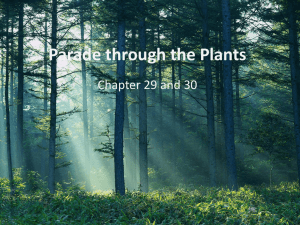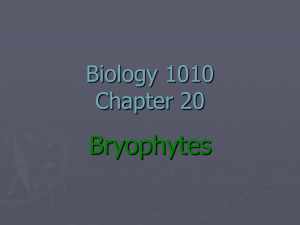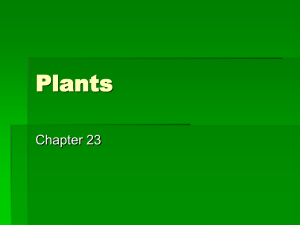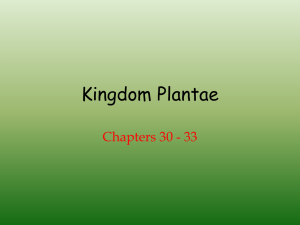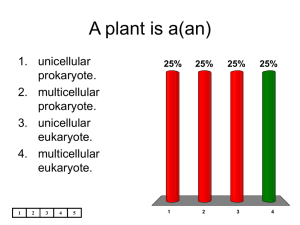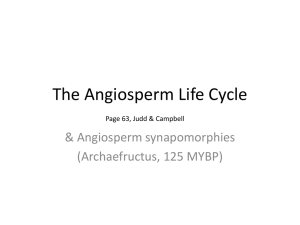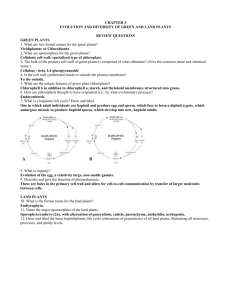chapter22
advertisement
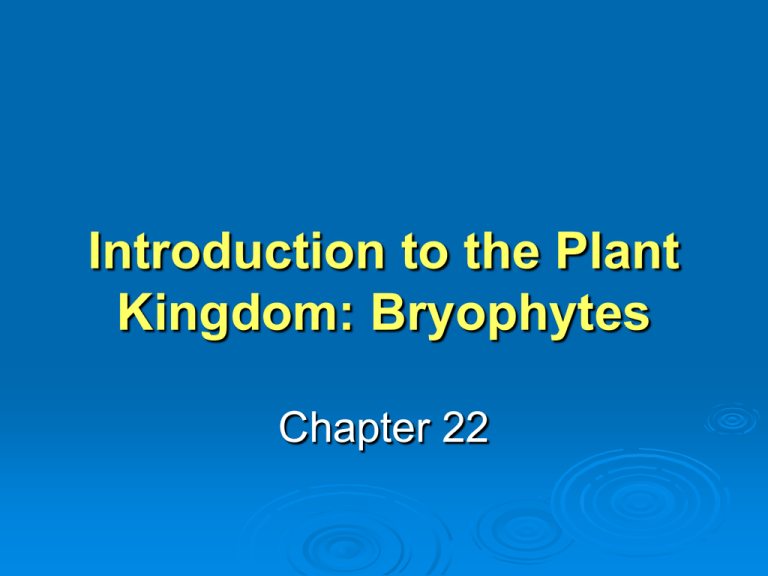
Introduction to the Plant Kingdom: Bryophytes Chapter 22 Mosses in Olympic National Park, WA. Sphagnum grows out onto the surface of a pond and gradually turns it into a quaking bog, which really does quake when you walk or jump on it. Eventually it becomes a bog with no free water. Peat farmer, digging turf in Ireland. Tollund Man, found in Denmark, was preserved by the tannic acids of a peat moss bog. Tollund Man • • • • • • • The Tollund Man lived during the late 5th century BC and/or early 4th century BC, about 2,400 years ago. He was buried in a peat bog on the Jutland Peninsula in Denmark, a find known as a bog body. He is remarkable for the fact that his body was so well preserved that he seemed to have died only recently. On May 6, 1950, the Højgård brothers from the small village of Tollund were cutting peat for their tile stove and kitchen range in the Bjældskovdal peat bog, 10 km west of Silkeborg, Denmark. Underneath the body was a thin layer of moss. Scientists know that this moss was formed in Danish peat bogs in the early Iron Age about the time when Jesus was born. Therefore, the body was suspected to have been placed in the bog approximately 2,000 years ago during the early Iron Age. Subsequent C14 radiocarbon dating of Tollund Man's hair indicated that he died in approximately 350 BC. The acid in the peat, along with the lack of oxygen underneath the surface, had preserved the soft tissues of his body. Examinations and X-rays showed that the man's head was undamaged, and his heart, lungs and liver were well preserved. LEARNING OBJECTIVE 1 • Discuss some environmental challenges of living on land • Describe how several plant adaptations meet these challenges Animation: Evolutionary Tree for Plants CLICK TO PLAY Colonization of Land • Plants required evolution of structural, physiological, reproductive adaptations • Plants produce gametes in multicellular gametangia that contain a protective layer of sterile cells KEY TERMS • CUTICLE • • A noncellular, waxy covering over the epidermis of aerial plant parts that reduces water loss STOMA • A small pore in the plant epidermis that allows gas exchange for photosynthesis Variation in Plants LEARNING OBJECTIVE 2 • Name the algal group from which plants are hypothesized to have descended • Describe supporting evidence Plant Ancestors 1 • Plants probably evolved from green algae • Similar biochemical characteristics: • • • pigments (chlorophylls a and b, carotenes, xanthophylls) cell-wall components (cellulose) carbohydrate storage material (starch) Plant Ancestors 2 • Similar fundamental processes • • such as cell division Land plants probably descended from charophytes (stoneworts) • Based on molecular and structural data Green algae gave rise to bryophytes. Chara is a green alga that has features similar to the alga that may have been ancestral to the bryophytes. Its growth habit is plantlike, although this may simply result from convergent evolution. Gametangia: Plants and Algae Developing gametes Sterile cell Multicellular gametangium Unicellular gametangium Fig. 22-2, p. 431 LEARNING OBJECTIVE 3 • Explain what is meant by alternation of generations • Diagram a generalized plant life cycle KEY TERMS • ALTERNATION OF GENERATIONS • • A type of life cycle characteristic of plants and a few algae and fungi They spend part of their life in a multicellular n gametophyte generation and part in a multicellular 2n sporophyte generation Animation: Haploid to Diploid Dominance CLICK TO PLAY Plant Life Cycle Gametophyte Spore Sperm Egg HAPLOID (n) GAMETOPHYTE GENERATION Fertilization Meiosis DIPLOID (2n) SPOROPHYTE GENERATION Zygote Embryo Sporophyte Fig. 22-3, p. 431 Gametophyte Spore Sperm Egg HAPLOID (n) GAMETOPHYTE GENERATION Meiosis Fertilization DIPLOID (2n) SPOROPHYTE GENERATION Zygote Embryo Sporophyte Stepped Art Fig. 22-3, p. 431 KEY TERMS • ANTHERIDIUM • • A multicellular male gametangium that produces sperm cells ARCHEGONIUM • A multicellular female gametangium that produces an egg Plant Gametangia The Gametophyte Generation • Produces haploid gametes by mitosis • • • Antheridium produces sperm cells Archegonium produces an egg Fertilization: Gametes fuse to form a diploid zygote KEY TERMS • SPORE • A reproductive cell that gives rise to individual offspring in plants, fungi, and certain algae and protozoa The Sporophyte Generation • First stage is zygote • • Develops into an embryo, protected and nourished by gametophyte plant Mature sporophyte plant has spore mother cells that undergo meiosis to produce haploid spores • First stage in gametophyte generation LEARNING OBJECTIVE 4 • Summarize the features that distinguish bryophytes from other plants Bryophytes • Small, fairly simple plants • Nonvascular • Gametophyte is dominant generation • grows independently of sporophyte and is usually perennial Plant Evolution Angiosperms Gymnosperms Ferns Club mosses VASCULAR SEEDLESS VASCULAR SEED PLANTS PLANTS Mosses Liverworts Hornworts NONVASCULAR BRYOPHYTES Evolution of seeds Evolution of dominant sporophyte, vascular tissue Green algal ancestor Evolution of cuticle, multicellular gametangia, multicellular embryos Fig. 22-5, p. 434 LEARNING OBJECTIVE 5 • Name and briefly describe the three phyla of bryophytes Three Phyla of Bryophytes • Mosses • Liverworts • Hornworts KEY TERMS • MOSS • A member of a phylum of spore-producing nonvascular plants in which the dominant n gametophyte alternates with a 2n sporophyte that remains attached to the gametophyte Mosses • Leafy moss gametophytes develop from a protonema • A moss sporophyte consists of a capsule, a seta, and a foot KEY TERMS • PROTONEMA • • In mosses, a filament of n cells that grows from a spore and develops into leafy moss gametophytes CAPSULE • Portion of the bryophyte sporophyte in which spores are produced Mosses Mosses A moss that survives drought. Tortula rurali is a genus of moss that lives in regions with only occasional rainfall. During dry periods, the plant looks completely dried out and dead. However, a few minutes after rain, the plants are rehydrated and fully functional. Mosses Capsule Seta Foot Fig. 22-6c, p. 435 Animation: Moss Life Cycle CLICK TO PLAY Alternation of Generation (Moss) • http://www.sumanasinc.com/webcontent/a nisamples/majorsbiology/moss.html Life Cycle: Mosses Gametophyte plants Buds on protonema Antheridia at the tip of the gametophyte shoot 1 Antheridia with sperm cells Spore germinates Spores released 6 Protonema Sperm cell HAPLOID (n) GAMETOPHYTE GENERATION 2 Archegonium with egg Fertilization Meiosis DIPLOID (2n) SPOROPHYTE GENERATION 5 Calyptra Spore mother cells that undergo meiosis Capsule Zygote 4 Sporophyte 3 Embryo Gametophyte plant Fig. 22-7, p. 437 KEY TERMS • LIVERWORT • A member of a phylum of spore-producing, nonvascular, thalloid or leafy plants with a life cycle similar to that of mosses KEY TERMS • THALLUS • • A body that lacks roots, stems, or leaves GEMMA • A small body of tissue that becomes detached from a parent liverwort and is capable of developing into a new organism Liverworts Liverworts Life Cycle: Liverworts Antheridiophore Germination of spores and development of young gametophyte 5 Spores released Archegoniophore Male thallus 1 Female thallus Antheridia with sperm cells Gemmae cup Male and female gametophyte plants HAPLOID (n) GAMETOPHYTE GENERATION Sperm cell Archegonia with eggs 2 Fertilization Meiosis DIPLOID (2n) SPOROPHYTE GENERATION 4 Foot Seta Zygote Tissue derived from archegonium Capsule Spore mother cells that undergo meiosis Embryo 3 Sporophyte Fig. 22-9, p. 439 Liverwort Gametangia and Sporophyte Antheridiophore Gametophyte thallus Fig. 22-10a, p. 440 Liverwort Gametangia and Sporophyte Fig. 22-10b, p. 440 Liverwort Gametangia and Sporophyte Foot Seta Capsule Fig. 22-10c, p. 440 KEY TERMS • HORNWORT • A member of a phylum of spore-producing, nonvascular thalloid plants with a life cycle similar to that of mosses Hornworts • Hornwort gametophytes are thalloid; their sporophytes form hornlike projections out of the gametophyte thallus Hornwort Mature sporangium splits open Spores Sporophyte Gametophyte with embedded archegonia and antheridia Fig. 22-11b, p. 441 LEARNING OBJECTIVE 6 • Describe the ecological significance of the mosses Mosses • Colonize rock previously colonized by lichens • • Help form thin soil in which grasses and other plants can grow Grow in dense colonies • Hold soil in place, help prevent soil erosion Mosses in Research
